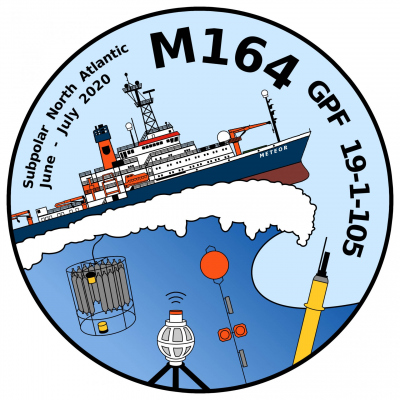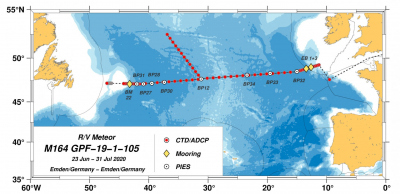- Home
- Research
- Expeditions
- 2020
- M164 (GPF-19-1-105)
M164 (GPF-19-1-105)
The oceanic circulation of the Atlantic Ocean is part of a global current system consisting of more or less northbound surface currents and southbound deep currents. Both are coupled through the deep water formation regions located in the North Atlantic and thus form the Atlantic Meridional Overturning Circulation (AMOC). This is reminiscent of a kind of global oceanic conveyor belt that distributes large amounts of heat, salt and gases dissolved in seawater.
An important component of the warm and saline branch of this conveyor is the Gulf Stream and its northern extension, the North Atlantic Current (NAC). This current contributes to enabling climatic conditions that are much milder in northwestern Europe than e.g. on the Canadian side of the North Atlantic. In return, cold and fresh waters originating in the Nordic Seas and in the Labrador Sea are transported back to tropical regions in the deep layers of the ocean. This deep branch supplies the ocean interior with oxygen and trace gases, thus contributing to the rejuvenation of the water layers in the deep ocean. In a few key regions of the North Atlantic, e.g. in the Labrador Sea, the Irminger Sea, and the Nordic Seas, these two branches are in direct contact. Through a chain of transformation processes, the sinking of surface waters takes place under certain conditions and thus the actual conversion of these waters into deep water, more precisely into North Atlantic Deep Water.
Computer simulations of the International Panel on Climate Change (IPCC) for the 21st century point to a weakening of deep water formation and thus a weakening of the strength of the meridional overturning circulation. This is favored by the increasing input of greenhouse gases into the atmosphere and thus by the increase in global warming and is expected to affect the presently prevailing climate conditions. In order to observe changes in the AMOC, corresponding sustainable oceanic measurement arrays located at choke-points of the North Atlantic circulation are required. Such a choke-point is located in the southern subpolar North Atlantic. Long-term observations conducted along 47°/48°N since 2006 allow to gain important insight into the strength and variation of the northward import of subtropical saline water into the subpolar North Atlantic or the southward export of North Atlantic Deep Water into the subtropics.
By means of cruise M164 (GPF-19-1-105) we aim at continuing the existing time series of the long-term ocean observatory called NOAC (“North Atlantic Changes”), which serves to capture the different components of the AMOC. The NOAC observatory is installed along 47°/48°N and comprises among others deep-sea moorings and bottom-mounted inverted echo-sounders (so-called PIES), all of which will be recovered during the cruise and relevant stored data will thus be obtained. Considered devices and methods include moored current-meters, temperature/salinity/pressure sensors, and ship-based observations (hydrographic properties of seawater, oceanic velocity, concentrations of gases dissolved in seawater). These data will be combined with and analyzed in conjunction with additional observational data (e.g. satellite data, data from autonomous Argo drifters) and models simulation products.
The planned measurements of RV METEOR-cruise M164 (GPF-19-1-105) shall contribute to further extending in time the existing time series regarding the current transports and water mass properties in order to assess the continuity of existing trends as well as to detect and understand the origin of noticeable variations. The resulting time series provide an important reference and benchmark for the climate modeling community. Putting the observations in relation to long-term observatories located northward and southward from the NOAC sites will allow to investigate the spatial and temporal coherence of variations in the AMOC strength.
RV METEOR-cruise M164 (GPF-19-1-105) is conducted in the framework of the project „RACE – Synthesis - Regional Atlantic Circulation and Global Change”, work package 1.2., funded by the Germany Ministry for Education and Research (BMBF). The work is furthermore done in close cooperation with the oceanography group of the German Federal Maritime and Hydrographic Agency (BSH) in Hamburg, Germany.

RV METEOR - Expedition M164 (GPF-19-1-105)
Emden (Germany) - Emden (Germany)
23 June – 31 July 2020
AMOC-components at 47°/48°N
Chief-Scientist:
Dr Dagmar Kieke
Phone: 0049 421 218 62154
Email: [Bitte aktivieren Sie Javascript]
Weekly reports



